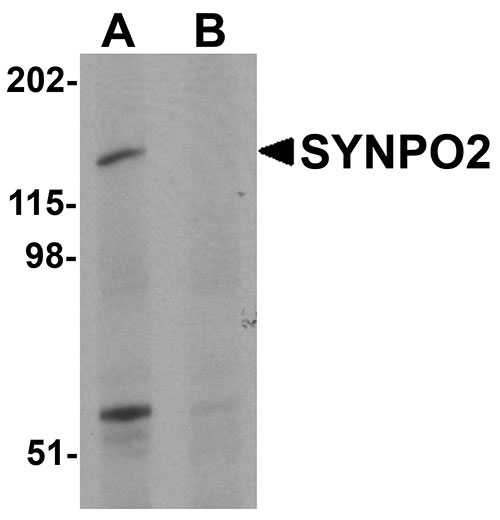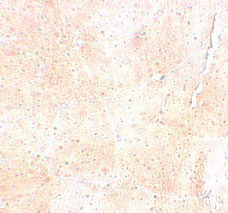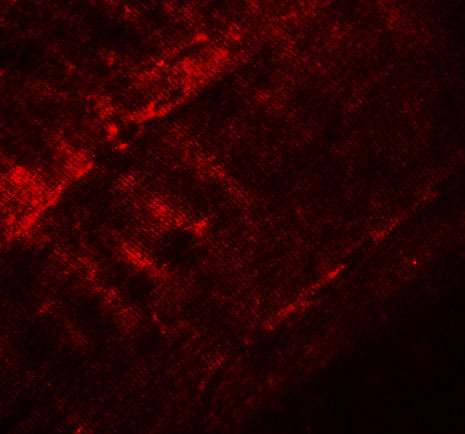SYNPO2 Antibody
- SPECIFICATION
- CITATIONS
- PROTOCOLS
- BACKGROUND

Application
| WB, IHC-P, IF, E |
|---|---|
| Primary Accession | Q9UMS6 |
| Other Accession | NP_597734, 193083183 |
| Reactivity | Human, Mouse |
| Host | Rabbit |
| Clonality | Polyclonal |
| Isotype | IgG |
| Calculated MW | 117514 Da |
| Application Notes | SYNPO2 antibody can be used for detection of SYNPO2 by Western blot at 1 µg/mL. Antibody can also be used for immunohistochemistry starting at 5 µg/mL. For immunofluorescence start at 20 µg/mL. |
| Gene ID | 171024 |
|---|---|
| Target/Specificity | SYNPO2; |
| Reconstitution & Storage | SYNPO2 antibody can be stored at 4℃ for three months and -20℃, stable for up to one year. As with all antibodies care should be taken to avoid repeated freeze thaw cycles. Antibodies should not be exposed to prolonged high temperatures. |
| Precautions | SYNPO2 Antibody is for research use only and not for use in diagnostic or therapeutic procedures. |
| Name | SYNPO2 |
|---|---|
| Function | Has an actin-binding and actin-bundling activity. Can induce the formation of F-actin networks in an isoform-specific manner (PubMed:23225103, PubMed:24005909). At the sarcomeric Z lines is proposed to act as adapter protein that links nascent myofibers to the sarcolemma via ZYX and may play a role in early assembly and stabilization of the Z lines. Involved in autophagosome formation. May play a role in chaperone-assisted selective autophagy (CASA) involved in Z lines maintenance in striated muscle under mechanical tension; may link the client-processing CASA chaperone machinery to a membrane- tethering and fusion complex providing autophagosome membranes (By similarity). Involved in regulation of cell migration (PubMed:22915763, PubMed:25883213). May be a tumor suppressor (PubMed:16885336). |
| Cellular Location | Nucleus {ECO:0000250|UniProtKB:Q91YE8}. Cytoplasm {ECO:0000250|UniProtKB:Q91YE8}. Cytoplasm, cytoskeleton. Cytoplasm, myofibril, sarcomere, Z line. Cell junction, focal adhesion. Note=Shuttles between the nucleus and the cytoplasm in a differentiation-dependent and stress-induced fashion. In undifferentiated myoblasts strongly expressed in the nucleus, after induction of myotube differentiation is located to both nucleus and cytoplasm along acting filaments, and in differentiated myotubes is located at the Z lines. Upon stress redistributes from cytoplasm of myoblasts and myotubes to the nucleus. Nuclear import is KPNA2-dependent and promoted by phosphorylation by PKA and/or CaMK2, and inhibition of calcineurin. The nuclear export is XPO1-dependent (By similarity). Localized in a fiber-like pattern, partly overlapping with filamentous actin (PubMed:18371299). {ECO:0000250|UniProtKB:Q91YE8, ECO:0000269|PubMed:18371299} [Isoform 2]: Cytoplasm, cytoskeleton. Note=Localizes to induced actin bundles with punctuate staining. [Isoform 4]: Cytoplasm, cytoskeleton. Note=Localizes to induced actin bundles with punctuate staining. |
| Tissue Location | Expressed in heart muscle. Isoform 5 is specifically expressed in skeletal muscle |

Thousands of laboratories across the world have published research that depended on the performance of antibodies from Abcepta to advance their research. Check out links to articles that cite our products in major peer-reviewed journals, organized by research category.
info@abcepta.com, and receive a free "I Love Antibodies" mug.
Provided below are standard protocols that you may find useful for product applications.
Background
SYNPO2 Antibody: SYNPO2 was initially identified as myopodin, a member of the synaptopodin family that contains one PPXY motif and multiple PXXP motifs. It colocalizes with alpha-actinin and is found at the Z-disc and during stress conditions will translocate to the nucleus, suggesting that it is part of signaling pathways in addition to its function as a structural protein. SYNPO2 has been shown to bind to calmodulin, alpha-actinin, and smooth muscle myosin and will stimulate actin polymerization in a calmodulin dependent manner, consistent with its proposed role in organizing the cytoskeleton. While deletion of SYNPO2 has been reported to be highly correlated with the invasiveness of prostate cancers, other reports suggest that down-regulation of SYNPO2 reduces the invasiveness and motility of prostate cancer cells.
References
Weins A, Schwarz K, Faul C, et al. Differentiation- and stress-dependent nuclear cytoplasmic redistribution of myopodin, a novel actin-bundling protein. J. Cell Biol.2001; 155:393-404.
Shroeter MM, Beall B, Heid HW, et al. In vitro characterization of native mammalian smooth-muscle protein synaptopodin. Biosci. Rep.2008; 195-203.
Lin F, Yu YP, Woods J, et al. Myopodin, a synaptopodin homologue, is frequently deleted in invasive prostate cancers. Am. J. Path.2001; 5:1603-12.
De Ganck A, De Corte V, Bruyneel E, et al. Down-regulation of myopodin expression reduces invasion and motility of PC-3 prostate cancer cells. Int. J. Oncol.2009; 34:1403-9.
If you have used an Abcepta product and would like to share how it has performed, please click on the "Submit Review" button and provide the requested information. Our staff will examine and post your review and contact you if needed.
If you have any additional inquiries please email technical services at tech@abcepta.com.













 Foundational characteristics of cancer include proliferation, angiogenesis, migration, evasion of apoptosis, and cellular immortality. Find key markers for these cellular processes and antibodies to detect them.
Foundational characteristics of cancer include proliferation, angiogenesis, migration, evasion of apoptosis, and cellular immortality. Find key markers for these cellular processes and antibodies to detect them. The SUMOplot™ Analysis Program predicts and scores sumoylation sites in your protein. SUMOylation is a post-translational modification involved in various cellular processes, such as nuclear-cytosolic transport, transcriptional regulation, apoptosis, protein stability, response to stress, and progression through the cell cycle.
The SUMOplot™ Analysis Program predicts and scores sumoylation sites in your protein. SUMOylation is a post-translational modification involved in various cellular processes, such as nuclear-cytosolic transport, transcriptional regulation, apoptosis, protein stability, response to stress, and progression through the cell cycle. The Autophagy Receptor Motif Plotter predicts and scores autophagy receptor binding sites in your protein. Identifying proteins connected to this pathway is critical to understanding the role of autophagy in physiological as well as pathological processes such as development, differentiation, neurodegenerative diseases, stress, infection, and cancer.
The Autophagy Receptor Motif Plotter predicts and scores autophagy receptor binding sites in your protein. Identifying proteins connected to this pathway is critical to understanding the role of autophagy in physiological as well as pathological processes such as development, differentiation, neurodegenerative diseases, stress, infection, and cancer.




